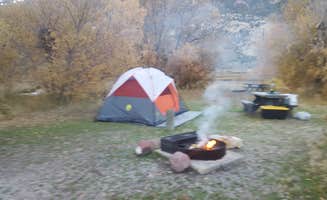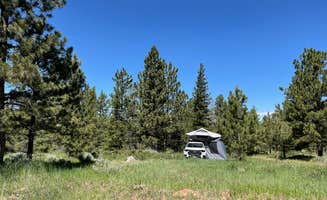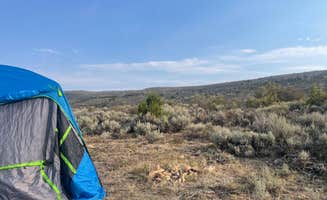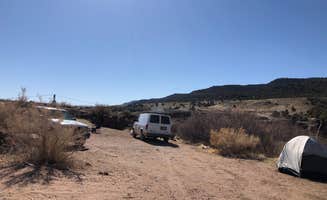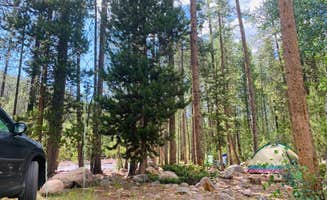Tent campsites near Vernal, Utah range from high-mountain pine forests at 7,000+ feet elevation to lower-elevation desert settings with minimal vegetation. Summer temperatures in the mountain camps typically range from 70-85°F during the day while dropping to 45-55°F at night, making sleeping bags necessary even in July. Winter camping options remain extremely limited as most forest roads close after the first significant snowfall in October or November.
What to do
Explore ancient petroglyphs: At Rainbow Park Campground, visitors can combine camping with viewing impressive rock art. A reviewer notes, "1.7 miles before the campground road there is a must see Petroglyphs site offering a couple of loop trails that bring you up the hill."
Fish in mountain streams: Whiterocks Campground offers excellent fishing opportunities directly from your campsite. According to a camper, "The best part about this campground is the fishing. If you get one of the sites towards the back of the campground the creek runs right by it and fishing for pan size trout is a blast."
Stargaze without light pollution: The remote locations of many dispersed sites provide exceptional night sky viewing. A camper at North of Dinosaur CR16 reports: "Quiet and serene with beautiful views. All the spots available on this road were gorgeous."
Practice wildlife photography: Early mornings at Rainbow Park offer opportunities to photograph elk and other wildlife. One visitor mentioned, "If you're lucky, you will come across the herd of elk roaming the grounds."
What campers like
Privacy between sites: Uinta Canyon Campground receives praise for its well-spaced sites. A reviewer commented, "The sites themselves are well maintained with a lot of open space between the sites."
Affordability: Most Forest Service dispersed camping areas near Vernal are free for up to 14 days. A camper at Utah Forest Road 13 shared: "We found a spot next to a stream on forest road 838. Very few campers in the area, all quiet and respectful."
Group accommodations: For family gatherings, Uinta Canyon offers dedicated group sites. One camper reported, "It easily accomadated 30 trailers, 8 large tents, about 70 of us, and 10 dogs. It had 2 toilet buildings that were cleaned and stocked daily by DNR, 4 horseshoe pits, the giant fire pit, a dumpster."
Easy access to trails: Many tent camping areas connect to hiking trails. A camper at Forest Service Road 217 noted, "I'm here in October and though chilly it's gorgeous! There are a lot of hunters here with their four wheels but no one has bothered me."
What you should know
Road conditions vary significantly: Many access roads become impassable after rain. A camper at Forest Service Road 217 Dispersed advised, "The road was pretty rough, some large divits and larger rocks on the road. I drive an outback so I just went slow and it was fine."
Limited facilities at dispersed sites: Most dispersed camping areas have no amenities. A Utah Forest Road 13 camper described finding "multiple minimal dispersed campsites, most with small man-made rock firepits and nothing else."
Wildlife concerns: Nesting birds can become territorial in spring. One camper recounted, "When I was out hiking around a bit I came upon a sage hen it tried to attack me and I was running and screaming and it didnt back down and was really gaining ground."
Cell service variability: Signal strength depends on elevation and terrain. A camper at North of Dinosaur CR16 reported "Peaceful low-mid T-Mobile" signal, while others noted complete absence of coverage in canyon areas.
Tips for camping with families
Geocaching opportunities: Rainbow Park Campground and surrounding areas offer numerous geocaches. A visitor to Uinta Canyon mentioned, "Several geocaches in the area so be sure to take your GPS."
Easier access camping: For families with young children, stick to established campgrounds with vault toilets. One parent advised, "This canyon actually has multiple campgrounds but I think they all fall under the Uintah canyon campgrounds... They are nicely spaced and at $5 a night it cant be beat."
Plan for insects: Mosquitoes can be prevalent in summer, particularly near water. A visitor warned, "Bring bug spray! The mosquitoes are vicious here."
Pack for temperature swings: Even in summer, nighttime temperatures drop significantly. One camper at Utah Forest Road 13 noted, "Set up shop as soon as I found it and glad I did. So quiet, big and open, trees for the hammock - basically everything I look for when I try and find a cool place to camp."
Tips from RVers
Vehicle clearance requirements: Many dispersed camping areas require higher clearance vehicles. A reviewer of Forest Road 13 warned, "FS road #13 has large diameter cobble base and makes for a bumpy road. There are much better dispersed sites across the hwy on FS roads #839 and #838 for RVs and TTs."
Alternative sites for larger rigs: Several forest roads offer better access for trailers. One RVer suggested, "I would not go up this road with a trailer unless you had a turnaround open. This area is best suited to overlander tent and truck camper types."
Know your limits: Be realistic about what your vehicle can handle. A camper shared their experience: "I crept in driving a Honda about 15 mph on the 20+ mile dirt road. Just when I thought I couldn't go any further, that I was hopelessly lost, I saw the sign pointing to the campground."


